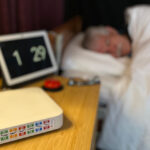Parents are being warned that notebook computers may be causing physical problems for their children.
The warning is contained in new guidelines around the use of computers by children.
The set of 12 evidence-based guidelines — the first of their kind — was produced by an international team of experts led by Professor Leon Straker, of Curtin University of Technology’s School of Physiotherapy.
The team, with representatives from Harvard University, the University of Queensland and the University of Washington, has researched the guidelines for more than 10 years.
Professor Straker said the Federal Government’s initiative to give students a notebook computer can have significant ramifications for children’s musculoskeletal wellbeing.
“With more children using notebook computers, parents and teachers should be wary about the weight of the notebook computer being provided to children and also how they will be carrying it,” he said.
“A lightweight notebook is important and a comfortable backpack with two straps should to be used when carrying it.”
Professor Straker said external devices like keyboards and mice should be provided to children using notebook computers at their desks, and they should be taught proper posture when using their notebooks.
“What we have found is that children only use notebook computers on their desks 34 per cent of the time, and other postures like lying prone, floor sitting and sitting with the computer on their laps, are very common,” he said.
“In light of this, alternatives to chair sitting postures should be encouraged only if these are reasonable postures.”
The new guidelines were recently published in the prestigious international journal Ergonomics.
“The potential impact of computer use on the physical development of children can be significant, and we hope that these guidelines will form the basis for teaching children the wise use of computers,” Professor Straker said.
“We also hope that equipment designers and suppliers will also take these guidelines into consideration.
“Online resources for parents, teachers and children will be developed and made available in the near future.”
Professor Straker said the guidelines were important because computer use by children was extremely high globally and the discomfort reported by children using computers was increasing.
“Nearly all children in affluent countries now use computers, with more than 90 per cent of households with children in Australia having a computer at home and over 90 per cent of enrolled school children in the United States using a computer at school,” he said.
“School children also typically use a computer for substantial periods of time each week, with many children reporting discomfort related to computer use.
“In Australia, one in five children reported soreness at least monthly and the soreness reported was not trivial in nature.
“Of those with soreness, one in four had to limit their activities, one in 10 took medication and one in 20 sought health professional advice.”
The full guidelines can be accessed for free at: http://www.informaworld.com/smpp/title~db=all~content=g920118495 courtesy of Taylor and Francis publishers and focus on:
- Encouraging a mix of seated and whole body movement tasks.
- Encouraging reasonable postures during computing tasks through workstation, chair, desk, display and input device selection and adjustment.
- Special issues regarding notebook computer use.
- Teaching children computing skills and to respond to discomfort.
Contact: Ann Marie Lim; Public Relations; Curtin; 08 9266 4241; 0401 103 532; ann.lim@curtin.edu.au


